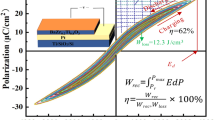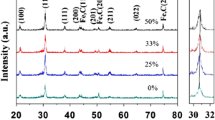Abstract
PbZrO3 and PbZrO3-based thin films as a typical antiferroelectric material have been widely studied for high-density energy storage capacitors. To prepare high-quality PbZrO3 films by the sol-gel method, it is necessary to fully understand the effects of precursor solution on the microstructure and electrical properties of the films. In this study, the microstructure and electric properties of the sol-gel-derived PbZrO3 thin films were studied as a function of the water/acetic acid ratio from 10/90 to 85/15 by volume in the precursor solution. The results indicate that the water/acetic acid ratio had a significant impact on the crystalline quality, microstructure, electrical properties, and energy storage performance of PbZrO3 thin films. When the water/acetic acid ratio was relatively low, that is, 20/80, the PbZrO3 thin films had the best antiferroelectric properties and energy storage performance. The films exhibited the well-developed hysteresis loop, with maximum polarization (Pmax) and remanent polarization (Pr) of 72.55 μC/cm2, and 3.71 μC/cm2, respectively. Due to the larger Pmax and smaller Pr, as well as enhanced electrical breakdown strength (EBDS), the films exhibited the maximum Wrec of 21.9 J/cm3 at 1000 kV/cm. Our results demonstrate that to obtain better antiferroelectric properties and energy storage performance, it is preferable to add a low proportion of water/acetic acid in the precursor sol-gel solution.
Graphical Abstract

The P-E hysteresis loops and energy storage performance of the PbZrO3 thin films prepared with the water/acetic acid ratio of (a) 10/90, (b) 20/80, (c) 35/65, (d) 85/15 under 600 kV/cm−1.
Highlights
-
Clarified the influence of water/acetic acid solvent ratio on the microstructure and electrical properties of PbZrO3 thin films.
-
A low proportion of water/acetic acid (20/80 volume ratio) can achieve better antiferroelectric performance.
-
PbZrO3 thin films with high energy storage performance were obtained by the sol-gel method.









Similar content being viewed by others
References
Wei XK, Domingo N, Sun Y, Balke N, Dunin-Borkowski RE, Mayer J (2022) Progress on emerging ferroelectric materials for energy harvesting, storage and conversion. Adv Energy Mater 12:2201199
Wang G, Lu Z, Li Y, Li L, Ji H, Feteira A, Zhou D, Wang D, Zhang S, Reaney I (2021) Electroceramics for high-energy density capacitors: current status and future perspectives. Chem Rev 121:6124–6172
Pan H, Lan S, Xu SQ, Zhang QH, Yao HB, Liu YQ, Meng FQ, Guo EJ, Gu L, Yi D, Wang XR, Huang HB (2021) Ultrahigh energy storage in superparaelectric relaxor ferroelectrics. Science 374:100–104
Zheng DW, Geng WP, Qiao XJ, Zhang L, Mu JL, Li YQ, Bi KX, Nian FS, He J, Chou XJ (2021) High energy storage of La-doped PbZrO3 thin films using LaNiO3/Pt composite electrodes with wide temperature range. J Sol-Gel Sci Techn 98:264–270
Liu Z, Lu T, Ye J, Wang G, Dong X, Withers R, Liu Y (2018) Antiferroelectrics for energy storage applications: a review. Adv Mater Technol 3:1800111
Wang HS, Liu YC, Yang TQ, Zhang SJ (2019) Ultrahigh energy-storage density in antiferroelectric ceramics with field-induced multiphase transitions. Adv Funct Mater 29:1807321
Liu XH, Yang TQ, Gong WP (2022) Achieving ultrahigh energy-storage capability in PbZrO3-based antiferroelectric capacitors based on optimization of property parameters. J Mater Chem A 10:4137–4145
Li YZ, Lin JL, Bai Y, Li YX, Zhang ZD, Wang ZJ (2020) Ultrahigh-energy storage properties of (PbCa)ZrO3 antiferroelectric thin films via constructing a pyrochlore nanocrystalline structure. ACS Nano 14:6857–6865
Li YZ, Wang ZJ, Bai Y, Zhang ZD (2020) High energy storage performance in Ca-doped PbZrO3 antiferroelectric films. J Eur Ceram Soc 40:1285–1292
Li YZ, Wang ZJ, Bai Y, Liu W, Zhang ZD (2019) Enhancement of energy storage density in antiferroelectric PbZrO3 films via the incorporation of gold nanoparticles. J Am Ceram Soc 102:5253–5261
Fang Y, Bai Y, Li YZ, Liu N, Zhang F, Wang C, Wang ZJ (2021) Improved energy storage performance of PbZrO3 antiferroelectric thin films crystallized by microwave radiation. RSC Adv 11:18387–18394
Nguyen MD, Guus R (2018) Electric field-induced phase transition and energy storage performance of highly-textured PbZrO3 antiferroelectric films with a deposition temperature dependence. J Eur Ceram Soc 38:4953–4961
Guo X, Ge J, Ponchel F, Remiens D, Chen Y, Dong XL, Wang GS (2017) Effect of Sn substitution on the energy storage properties of high (001)-oriented PbZrO3 thin films. Thin Solid Films 632:93–96
Moret MP, Schermer JJ, Tichelaar FD, Aret E, Hageman PR (2002) Structure and morphology of epitaxial PbZrO3 films grown by metalorganic chemical vapor deposition. J Appl Phys 92:3947–3957
Yu ZY, Cai HH, Fu ZQ, Zhang LL, Chen XF, Wang GS, Dong XL, Xu FF (2020) Microstructural evolution in chemical solution deposited PbZrO3 thin films of varying thickness. J Appl Phys 128:235302
Coulibaly MD, Caroline B, Renoud R, Gundel HW (2021) Effect of zirconium hydrolysis degree on the dielectric properties of PbZrO3. J Mater Sci Mater Electron 32:15964
Yi G, Sayer M (1996) An acetic acid/water based sol-gel PZT process II: formation of a water based solution. J Sol-Gel Sci Techn 6:75–82
Wolf C, Rüssel C (1992) Sol-gel formation of zirconia: preparation, structure and rheology of sols. J Mater Sci 27:3749–3755
Nourmohammadi A (2010) Template-based electrophoretic growth of PbZrO3 nanotubes. J Sol-Gel Sci Techn 53:342–346
Hao XH, Zhai JW, Zhou F, Song XW, An SL (2010) Thickness and frequency dependence of electric-field-induced strains of sol-gel derived (Pb0.97La0.02)(Zr0.95Ti0.05)O3 antiferroelectric films. J Sol-Gel Sci Techn 53:366–371
Wang Y, Hao XH, Xu JB (2012) Effects of PbO insert layer on the microstructure and energy storage performance of (042)-preferred PLZT antiferroelectric thick films. J Mater Res 27:1770–1775
Tani T, Payne D (1994) Lead oxide coatings on sol-gel-derived lead lanthanum zirconium titanate thin layers for enhanced crystallization into the perovskite structure. J Am Ceram Soc 77:1242–1248
Chen B, Yu HY, Shao Y, Bai Y, Hu R, Zeng ZM, Zhang F, Wang ZJ (2023) A novel way to prepare PbZrO3 nanocomposite films for increasing electrical properties and energy storage performance. J Alloy Compd 960:170873
Tani T, Li JF, Viehland D, Payne DA (1994) Antiferroelectric‐ferroelectric switching and induced strains for sol‐gel derived lead zirconate thin layers. J Appl Phys 75:3017–3023
Zhao Y, Gao HC, Hao XH, Zhang Q (2016) Orientation-dependent energy-storage performance and electrocaloric effect in PLZST antiferroelectric thick films. Mater Res Bull 84:177–184
Ong RJ, Payne DA, Sottos NR (2010) Processing effects for integrated PZT: residual stress, thickness, and dielectric properties. J Am Ceram Soc 88:2839–2847
Wang GS, Meng XJ, Yu J, Sun JL, Lai ZQ, Guo SL, Chu JH (2001) Effect of hydrolysis on properties of PbZr0.50Ti0.50O3 ferroelectric thin films derived from a modified sol–gel process. J Cryst Growth 233:269–274
Livage J, Henry M, Sanchez C (1988) Sol-gel chemistry of transition metal oxides. Prog Solid St Chem 18:259–341
Yoldas BE (1986) Hydrolytic polycondensation of Si(OC2H5)4 and effect of reaction parameters. J Non-Cryst Solids 83:375–390
Yi GH, Sayer M (1996) An acetic acid/water based sol-gel PZT process I: Modification of Zr and Ti alkoxides with acetic acid. J Sol-Gel Sci Techn 6:65–74
Tuttle BA, Headley TJ, Bunker BC, Schwartz RW, Zender TJ, Hernandez CL, Goodnow DC, Tissot RJ, Michael J (1992) Microstructural evolution of Pb(Zr,Ti)O3 thin films prepared by hybrid metallo-organic decomposition. J Mater Res 7:1876–1882
Bleazard JG, Sun TF, Teja AS (1996) The thermal conductivity and viscosity of acetic acid-water mixtures. Int J Thermophys 17:111–125
Butler TM, Maccraith BD, Mcdonagh C (1998) Leaching in sol–gel-derived silica films for optical pH sensing. J Non-Cryst Solids 224:249–258
Mudinepalli VR, Feng L, Lin WC, Murty BS (2015) Effect of grain size on dielectric and ferroelectric properties of nanostructured Ba0.8Sr0.2TiO3 ceramics. J Adv Ceram 4:46–53
Kong LB, Ma J (2000) Preparation of crack-free antiferroelectric PbZrO3 thin films by a two-step annealing process. Appl Phys Lett 77:2584–2586
Shirane G, Sawaguchi E, Takagi Y (1951) Dielectric properties of lead zirconate. Phys Rev 84:476–481
Si YY, Zhang TF, Chen ZH, Zhang QH, Xu S, Lin T, Huang HL, Zhou C, Chen SQ, Liu SZ, Dong YQ, Liu CH, Tang YL, Lu YL, Jin KJ, Guo EJ, Lin X (2022) Phase competition in high-quality epitaxial antiferroelectric PbZrO3 thin films. ACS Appl Mater Interfaces 14:51096–51104
Zhu MM, Du ZH, Chng SS, Tsang SH, Teo EHT (2018) Strong electro-optically active Ni-substituted Pb(Zr0.35Ti0.65)O3 thin films: toward integrated active and durable photonic devices. J Mater Chem C 6:12919
Zhao Y, Hao XH, Zhang Q (2015) Improved electrocaloric effect in (100)-oriented Pb0.97La0.02(Zr0.57Sn0.38Ti0.05)O3 antiferroelectric thick film by interface engineering. J Alloy Compd 653:260–265
Zhai JW, Chen H (2003) Direct current field and temperature dependent behaviors of antiferroelectric to ferroelectric switching in highly (100)-oriented PbZrO3 thin films. Appl Phys Lett 82:2673
Waser R (1992) TrI4: the role of grain boundaries in conduction and breakdown of perovskite-type titanates. Ferroelectrics 133:109–114
Ahn CW, Amarsanaa G, Won SS, Chae SA, Lee DS, Kim IW (2015) Antiferroelectric thin-film capacitors with high energy-storage densities, low energy losses, and fast discharge times. ACS Appl Mater Interfaces 7:26381–26386
Wang XW, Chen JY, Hu SY, Yu KX, Shi YJ, Li JH, Hou MZ, Liu AD, Zheng MM, Yin SQ, Hu YC, Shang J (2023) Enhanced energy storage properties in PbZrO3 thin films via the incorporation of NiO. Curr Appl Phys 52:24–30
Sa TL, Cao ZP, Wang YJ, Zhu HB (2014) Enhancement of charge and energy storage in PbZrO3 thin films by local field engineering. Appl Phys Lett 105:142905–514
Shangguan DD, Duan YN, Wang BL, Wang C, Li JX, Bai Y, Zhang F, Li YZ, Wu YS, Wang ZJ (2021) Enhanced energy-storage performances of (1-x)PbZrO3-xPbSnO3 antiferroelectric thin films under low electric fields. J Alloy Compd 870:159440
Coulibaly MD, Borderon C, Renoud R, Gundel HW (2020) Enhancement of PbZrO3 polarization using a Ti seed layer for energy storage application. Thin Solid Films 716:138432
Ge J, Remiens D, Dong XL, Chen Y, Costecalde J, Gao F, Cao F, Wang GS (2014) Enhancement of energy storage in epitaxial PbZrO3 antiferroelectric films using strain engineering. Appl Phys Lett 105:112908
Zhang TD, Zhao Y, Li WL, Fei WD (2019) High energy storage density at low electric field of ABO3 antiferroelectric films with ionic pair doping. Energy Storage Mater 18:238–245
Ge J, Remiens D, Costecalde J, Chen Y, Dong XL, Wang GS (2013) Effect of residual stress on energy storage property in PbZrO3 antiferroelectric thin films with different orientations. Appl Phys Lett 103:162903
Acknowledgements
This work was supported by the Central Government Guiding Local Science and Technology Development Funds of Liaoning Province in 2021 [No. 2021JH6/10500168].
Author Contributions
Z.Y.Wen.: Investigation, Data curation, Writing-original, draft. Y.H.Ming.: Validation. S.M.Ding.: Visualization. C.C.Zhao.: Conceptualization. Y.Bai.: Conceptualization, Writing-review & editing. Z.J.Wang.: Supervision, Writing-review &; editing. The first draft of the manuscript was written by Z.Y.Wen. and all authors commented on previous versions of the manuscript. All authors read and approved the final manuscript.
Funding
This work was supported by the Central Government Guiding Local Science and Technology Development Funds of Liaoning Province in 2021 [No. 2021JH6/10500168].
Author information
Authors and Affiliations
Corresponding author
Ethics declarations
Conflict of interest
The authors declare no competing interests.
Additional information
Publisher’s note Springer Nature remains neutral with regard to jurisdictional claims in published maps and institutional affiliations.
Rights and permissions
Springer Nature or its licensor (e.g. a society or other partner) holds exclusive rights to this article under a publishing agreement with the author(s) or other rightsholder(s); author self-archiving of the accepted manuscript version of this article is solely governed by the terms of such publishing agreement and applicable law.
About this article
Cite this article
Wen, Z.Y., Bai, Y., Ma, Y.H. et al. Improving energy storage performance of sol-gel-derived PbZrO3 thin films by adjusting the water/acetic acid solvent ratio. J Sol-Gel Sci Technol (2024). https://doi.org/10.1007/s10971-024-06375-z
Received:
Accepted:
Published:
DOI: https://doi.org/10.1007/s10971-024-06375-z




